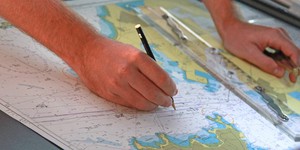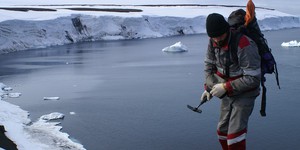Log In
Summary
*Note:
For this science project you will need to develop your own experimental procedure. Use the information in the summary tab as a starting place. If you would like to discuss your ideas or need help troubleshooting, use the Ask An Expert forum. Our Experts won't do the work for you, but they will make suggestions and offer guidance if you come to them with specific questions.
If you want a Project Idea with full instructions, please pick one without an asterisk (*) at the end of the title.
If you want a Project Idea with full instructions, please pick one without an asterisk (*) at the end of the title.
Abstract
Get good photographs of the Moon showing lots of craters and count how many craters you find in a range of diameter classes. One useful source is the Consolidated Lunar Atlas (Kuiper et al, 2006). Make a histogram that shows the distribution of diameters. Most of these craters were formed during the first billion years of the Moon's formation, but you should confirm that this is true for the the Moon areas you've selected in your photographs by doing background research. Is cratering uniform across the surface of the Moon? Can you find evidence to support the assumption that the frequency of craters you count for each size range can be related to the cratering time scale for that size range? Perhaps this will be true only in certain areas of the Moon's surface. Perhaps you will find other clues to distinguish ancient craters from more recent ones. But if the assumptions above hold true, the interval between small cratering events is just the number of those craters you count over the whole Moon, divided by 1 billion years. With this information, you could estimate the ages for some of the larger craters you find in which smaller craters are seen inside them (Odenwald, 1997; Wood, C., 2006; Kuiper et al., 2006).Bibliography
- Kuiper, et al. Consolidated Lunar Atlas. available online from the Lunar and Planetary Institute. Retrieved July 31, 2006.
- Odenwald, S., 1997. Questions and Answers. Ask the Astronomer, Astronomy Cafe website. Retrieved March 6, 2018.
Ask an Expert
Do you have specific questions about your science project? Our team of volunteer scientists can help. Our Experts won't do the work for you, but they will make suggestions, offer guidance, and help you troubleshoot.
Careers
If you like this project, you might enjoy exploring these related careers:
Career Profile
Astronomers think big! They want to understand the entire universe—the nature of the Sun, Moon, planets, stars, galaxies, and everything in between. An astronomer's work can be pure science—gathering and analyzing data from instruments and creating theories about the nature of cosmic objects—or the work can be applied to practical problems in space flight and navigation, or satellite communications.
Read more
Career Profile
Maps can give us much more information than ways to get from A to B. Maps can give us topographic, climate, and even political information. Cartographers and photogrammetrists collect a vast amount of data, such as aerial data and survey data to produce accurate maps and models. For example, by collecting rainfall data, a cartographer can make an accurate model of how rainfall can affect an area's watershed. The maps and models can then be used by policy makers to make informed decisions.
Read more
Career Profile
When you hear the word geography, you might think of maps and names of state capitals, but the work of geographers is much more than creating maps and identifying places. Geographers look at how people, places, and Earth are connected. They study the economy, social conditions, climate, and topography of a region to help answer questions in urban and regional planning, business, agriculture, and medicine.
Read more
Career Profile
Just as a doctor uses tools and techniques, like X-rays and stethoscopes, to look inside the human body, geoscientists explore deep inside a much bigger patient—planet Earth. Geoscientists seek to better understand our planet, and to discover natural resources, like water, minerals, and petroleum oil, which are used in everything from shoes, fabrics, roads, roofs, and lotions to fertilizers, food packaging, ink, and CD's. The work of geoscientists affects everyone and everything.
Read more
Related Links
Cite This Page
General citation information is provided here. Be sure to check the formatting, including capitalization, for the method you are using and update your citation, as needed.MLA Style
Science Buddies Staff.
"Lunar Crater Counting." Science Buddies,
20 Nov. 2020,
https://www.sciencebuddies.org/science-fair-projects/project-ideas/Astro_p029/astronomy/lunar-crater-counting?class=AQXt8SffNSQLZ6ZDqWKKKIYRj9M5DZ8rO-O0Vom-ZlX4GWB7ctxuyScrskSzkjlqPmCv64aB21VfA_9vw91Ysyf2.
Accessed 26 Apr. 2024.
APA Style
Science Buddies Staff.
(2020, November 20).
Lunar Crater Counting.
Retrieved from
https://www.sciencebuddies.org/science-fair-projects/project-ideas/Astro_p029/astronomy/lunar-crater-counting?class=AQXt8SffNSQLZ6ZDqWKKKIYRj9M5DZ8rO-O0Vom-ZlX4GWB7ctxuyScrskSzkjlqPmCv64aB21VfA_9vw91Ysyf2
Last edit date: 2020-11-20
Explore Our Science Videos
Do Veritasium's Helicopter Rope Experiment at Home
Video: Winding Coil
Program Your Own COVID-19 Simulator with Scratch










